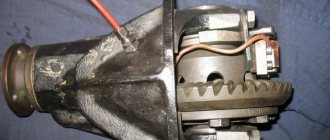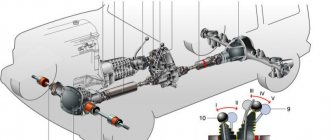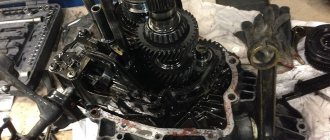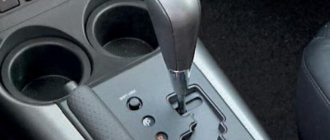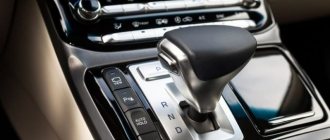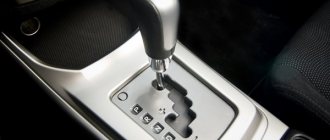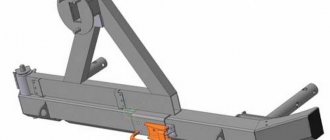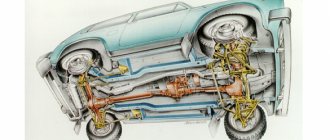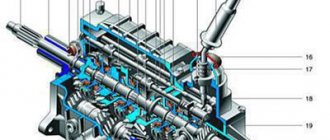TRANSFER CASE SHIFTING
Transfer case levers and their positions
The gear shift lever in the transfer case can occupy the following positions:
H - low gear;
N - neutral position;
B - top gear.
The differential lock lever in the transfer case can occupy the following positions:
P - differential unlocked;
B - differential is locked. When the lever is moved to this position, a warning light comes on in the instrument cluster, warning that the differential is locked.
NOTE Shifting from low to high gears and locking the differential can be done while driving with the clutch disengaged.
It is recommended to engage low gear in the transfer case after the vehicle has come to a complete stop and with the engine disconnected from the transmission.
To overcome difficult sections of the road, block the differential in advance. Do not lock the differential when the car's wheels are slipping. After overcoming such sections, unlock the differential - driving the car on good roads with a locked differential shortens the life of the power transmission mechanisms, increases tire wear and fuel consumption, and when braking the car can lead to skidding.
SHIFTING TRANSMISSION GEARS
Gear shift diagram (also printed on the handle)
Before driving, check the position of the transfer case levers - it must correspond to the road conditions. Start driving in first gear and, as the crankshaft speed increases, move to higher gears in a timely manner.
In time and in accordance with the road situation, change to a lower gear in the gearbox, avoiding overloading the engine.
To move in reverse, press the gear shift lever, pushing it all the way down and move it to the position corresponding to engaging reverse gear. Engage reverse gear only when the car is completely stopped.
Video
The relatively complex scheme for distributing torque from the internal combustion engine to the wheels is explained by the universal purpose of the Niva 2121 - if used correctly, it can be used comfortably in the city and along muddy country roads. Such properties are ensured by the presence of a transfer case with a center differential lock, complementing a 4- or 5-speed manual transmission, depending on the year of manufacture. The lever, located closer to the dashboard , is responsible for turning off/on the center differential, the second “small” lever controls the range multiplier and has 3 positions: high and low rows, as well as neutral.
Design and principle of operation of the Niva 2121 transfer case
The transfer case mechanism includes more than 60 independent parts, which is confirmed by the presented drawing. Therefore, it is quite prudent to name the main elements and their purpose.
- Housing Differential housing Shafts Couplings Seals Pinions Gears Flanges Levers
A pair of gears are tightly seated on the drive shaft, one of them (large) is intended for high gear, the second (small) is responsible for low gear. They have serrations with straight and oblique profiles. The first ones are in contact with the coupling, the second ones - with the intermediate shaft. The inclusion of one or another row causes the coupling to move along the hub in the horizontal direction, after which it is connected to the gear on the transfer case drive shaft.
The intermediate position turns off the gearbox ( the gearbox is open ), and the car cannot be moved in this mode. The front helical gear on the intermediate shaft is used to control the differential. The locking is engaged, or the rigid coupling of the drive shafts of both axles, is carried out through a clutch. The design is typical for modifications 21213 and 21214, and the latter is additionally equipped with a speed sensor drive.
In the operating state (with the transfer case reduction gear connected), the gear ratio in the first stage changes from 4.4 to 7.83, the second - from 2.52 to 4.58, the third - from 1.63 to 2.9, in the fourth - from 1.2 to 2.14, fifth - from 0.98 to 1.75, which is expressed in an increase in traction on the wheels.
When to use and how to disable blocking
It is preferable to enable forced blocking in various modifications of the Niva in the following situations:
- The blocking must be turned on in advance if you have to overcome a difficult route.
- On sharp climbs uphill or when driving downhill.
- While crossing terrain with a top layer of sand.
- When you have to drive on snow drifts or an icy road.
Wheel locking is not necessary when driving quietly on a flat road within the city. Grip on asphalt surfaces will be decent, and traction will be distributed evenly by default.
How to use a transfer case with a range multiplier on a Niva 2121
The normal position for the RK handles, ensuring adequate behavior on the road of good quality:
- Front - away from you Back - towards you
The special operating mode of the transmission is switched on not long before the car begins to overcome an obstacle (rut, mud, ford or rise). The transition to the lowest row must be done while stopping. Returning to top gear is allowed on the go, although it causes problems for beginners due to the lack of the usual synchronizer. It is somewhat more difficult to properly handle the forced manual locking of the center differential. On the contrary, it turns on when the car moves slightly (up to 20 km/h) due to misalignment of the grooves on the locking clutch, satellites and ring gear. To simplify turning the lever into the desired position, taking into account the Niva 2121 transfer case, pick up a small speed, then, shaking the steering wheel, pull the handle towards you.
Tips for owners
To make driving your car comfortable, read some important points:
- The usual, standard arrangement of the front and rear handles is forward and backward, respectively. Movement in this mode can and should be carried out in areas characterized by even and smooth surfaces.
- Locking the differential by switching the front handle to the rear position is best on roads characterized by increased slipperiness. This measure will give Niva stability. It is worth understanding that after overcoming the problem area, the handle will need to be returned to its original position.
- As noted earlier, downshift should be activated before a potential obstacle, but not while the car is already stuck.
- It is worth understanding that activating the lock when the vehicle is stationary is sometimes impossible, even if the clutch is depressed. This may be caused by the clutch teeth hitting the gear teeth. In this case, you can try to activate the lock by starting to drive slowly and make a slight turn. If problems arise with disabling the lock, it is recommended to perform the same procedure with the clutch depressed and the steering wheel slightly rocked.
Possible problems
Harsh operation and insufficient attention to how to use the transfer case on the Niva 2121 lead to the appearance of:
- Vibrations in the body while moving Vibrations when starting Hum Noise when maneuvering Tight switching on modes
Experience shows that the culprits are: insufficient oil level, incorrect centering of the steering wheel, loosening of the support fastenings and damage to the rubber bands. An additional influence is exerted by the condition of the cardan and the engine itself.
The Chevrolet NIVA SUV is equipped with a five-speed gearbox, as well as a transfer case with a range and a center differential lock.
When purchasing this car for the first time, the car owner does not always know how to use such a transmission correctly, when and under what conditions it is necessary to engage the lock, and when to lower it.
Transfer case purpose
The key purpose of the unit is to distribute the moment of force of the internal combustion engine to the wheel axles. Simply put, the multiplier directs the required force to each axis during movement. This is expressed as follows:
- Niva 2121 transfer case simplifies movement on off-road and unstable soils;
- blocks the center differential;
- disabling one of the vehicle's axles;
- increasing the torque of the driving pair of wheels;
- installation of power take-off for additional equipment.
Gear Modes
Let's take a closer look at how to use the transfer case on a Chevrolet Niva. It serves to switch to a lower gear and also blocks the center differential; this can be done at the same time. In order to engage a lower gear, you need to shift the lever to the right and up; to lock the lever, you need to pull it to the left all the way. The handle has the following designation:
- Low (L) - decrease;
- N-neutral;
- High (H) - normal, increased.
The figure below shows a diagram of the operation of the transmission levers, gearbox and transfer case:
Main problems with the range multiplier
The main function of the range multiplier has the properties of a gearbox divider; it turns them on or off the gear speed.
Most transfer case breakdowns are purely mechanical in nature (for example, a cut shaft between the gearbox and the transfer case). This is provoked by inattention to fuel and lubricant levels, wear of rubber bands, incorrect location (alignment) of the unit, and the condition of adjacent components. The first indicator of problems with the transfer case is characteristic noise and vibration in the body.
Vibration when driving on Niva
The first reason is that at a speed of more than 70 km per hour, it’s all about the cardan shaft; only the original one must be installed. Next, replace the crosspiece on the cardan shaft, after which you must drag the shaft to a stand and balance it, otherwise the vibration will resume.
Important: The shaft itself on the Niva lasts two years, then it must be replaced. It is better to order from the manufacturer, this is not difficult to do on the Internet.. The second reason for vibration is the intermediate shaft, it must also be original, otherwise it will quickly fail
We take only the original AvtoVAZ one from the factory, otherwise vibration and breakdowns cannot be avoided
The second reason for vibration is the intermediate shaft, it must also be original, otherwise it will quickly fail. We take only the original AvtoVAZ one from the factory, otherwise vibration and breakdowns cannot be avoided.
The third reason for vibration is the breakdown of the gearbox flange bearings. To eliminate the problem, place additional support on the gearbox.
How to overcome noise when maneuvering in a transfer case
You can buy new handles for the levers. We change it ourselves, prying up the support with a screwdriver, take out the lever axis and get rid of the old handles. We remove the old lever springs and install new ones. Insert the lever axis and secure it with a corkscrew nut. Now, when driving with the new handles, there is no characteristic noise in the cabin. The handles can be easily changed without leaving the salon.
Stiff switching of the lock lever
This issue can be easily solved in the following way: when driving, just turn the steering wheel slightly and the lock will immediately turn on without any problems.
There are also: jamming of the pneumatic cylinder, sticking in the neutral position, or the rod is sitting tightly. Burnt gear and shift fork.
Transfer case for Niva, signs of breakdowns:
- problematic engagement of the front axle;
- overheating of the range multiplier;
- leakage or excessive consumption of oil during operation of the transfer case;
- self-switching of the front axle.
Repairing the transfer case in Niva 21213 with your own hands is quite possible in case of minor breakdowns. The owner of a Chevy Niva will only need the basic skills of a car mechanic. It is more difficult to correctly install and center the Niva transfer case. Here it is still recommended to contact a car service. A diagram of the unit itself is presented in the vehicle documentation.
Possible problems
Quite often, car owners do not know how to use the transfer case on a Niva, and may encounter the fact that the center lock does not turn off, and they have to drive along the highway in this mode, which negatively affects the car. In order to switch the transmission to normal mode, you need to switch to reverse gear and accelerate a little, and while reversing, try to dislodge the lock. If this doesn't work, you can try to do the same thing, only while moving forward.
To avoid transmission problems, Niva car owners must adhere to the following rules:
- Try not to change gears while slipping;
- If the lock switches with difficulty, there is no need to apply excessive force;
- When a difficult-to-pass section has been overcome, it is necessary to unlock it again, since on a flat road in this mode at high speeds the car’s controllability deteriorates, and the service life of the entire transmission decreases.
Here are the basic rules by following which you can significantly extend the life of the gearbox on a Chevrolet Niva.
Rules for using differential
These include:
- Switching the transfer case should only be done when the car is not moving.
- You can also engage the differential while the vehicle is moving.
- You can switch to a lower gear while the car is moving.
- To ensure long-term and uninterrupted operation of the differential, it is necessary to periodically turn it on, especially in winter. This should be done once every 7 days.
To ensure that the locking mechanism lasts for a long time, use the following rules:
- It is necessary to switch the transfer case when the Niva does not move.
- The differential can also be engaged while the vehicle is moving.
- To ensure efficient and long-term operation of the device, it is advisable for the Niva driver to turn on the lock from time to time. Once a week in winter is enough.
Where is the lever responsible for switching located? Pay attention to the area between the wings located in front, there are 2 levers there. One makes it possible to change gears at the gearbox, the other successfully controls the transfer case.
The basis of the transfer case is a gearbox, which includes 2 stages. The control lever comes directly from it, you can move it forward and backward - this is how the gear is changed on the Niva. The direction of movement of the lever to the left and right allows you to activate the differential lock and vice versa to disable it.
Read news about the new Niva
- How does the ignition system of the VAZ 21213 (Niva) work?
- Tire size for the field, all-season tires for the field 4×4, mud tires, the best winter tires for wheels r16 "
- Towbars for Chevrolet Niva in Stupino buy inexpensively in the online store with delivery | 40NOG
- The back door rattles on a Chevrolet Niva
- How to measure tire pressure - 16 pressure gauge test - Behind the Wheel magazine
- Niva body polishing
- Technical characteristics of Chevrolet Niva - 1.7 engine, fuel consumption, body dimensions
- Chevrolet Niva wipers - repair and replacement
Overcoming a deep puddle
Often a dispute arises between motorists about how best to cross a ford with a transfer case. Some people prefer to “fly” into a puddle from acceleration, others prefer to downshift. If you get into a mud pit, there is a high risk of water hammer - water gets into the cylinders through the filter, and the engine “chokes.”
To exclude this, many install a special snorkel. But you can do without it. A deep puddle should be overcome in second low gear. This is done so that in case of trouble (when the car starts to fail) you can switch to first gear in time and not stall. If you enter the water from acceleration (which is a better decision), remember that the wheels may get stuck in the middle of the journey. The engine power is not enough to turn the wheels - the car stalls, and the engine experiences a hydraulic shock.
Varieties
There are several types of these elements:
- Equipped with coaxial drive shafts. This type is used on many SUVs. It gained such popularity due to the use of a single main gear for both axles.
- With a misaligned driven shaft. There is no intermediate shaft here. The advantages of this system are high efficiency and noiselessness. Also, this box has a low curb weight.
- With drive axle drive blocking. It is also installed on the Chevrolet Niva. Here it is possible to use all the torque without slipping the wheels, which is very important when driving off-road. The front axle engages only on difficult sections of the road. On asphalt surfaces, the SUV has a single-wheel drive (only the rear axle works). This allows you to reduce fuel consumption and, if necessary, increase cross-country ability (when the drive “closes”). There is also an interaxle forced locking.
The design of the car provides for the presence of a transfer case, similar to the unit that is installed on the VAZ 2121. In this case, the so-called small-module RK with single-row or double-row bearings are used.
About 1000 copies of the Chevrolet Niva modification FAM-1. They were equipped with gearboxes from Suzuki Grand Vitara combined with a transfer case.
